


 |
September 18, 2013: Crathes Castle and Aberdeen, Scotland |
 |
September 16, 2013: A Day in Stirling, Scotland |
 |
Return to the Index for Our British Isles Trip |
Today we leave Edinburgh to head north to the town of Aberdeen, Scotland. On the way, we plan to stop at Glamis Castle and take a tour of the castle and grounds. Then we'll complete the journey to Aberdeen, check in to our hotel, and have dinner somewhere in the city.
The Drive from Edinburgh to Glamis Castle, Scotland
We drove north through the city, found the route for points north and presently came across the Forth Road Bridge, the beautiful bridge that spans the Firth of Forth (a "firth" being the mouth of a river when it reaches the sea or ocean; in this case, the Forth River).
|
 |
As we crossed the bridge, I made a movie and while it was not a nice day, you might want to watch it anyway, and you can do so with the player below, left.
|
Crossing the Forth Road Bridge |
 |
We continued north on the M90 motorway towards Perth. (Motorways, with the "M" designation, are similar to our Interstate highways or limited-access expressways. They do not allow actual intersections, and there are kinds of rules as to lane size, median size, shoulders and that sort of thing. "A" roads are more like "divided highways" here. While there are multiple lanes in either direction separated by a median, crossroads are allowed. If the crossroad is an important one, there will be a roundabout.)
At Perth, we headed off northeast on the A90 highway towards Aberdeen, eventually turning north off that highway onto the A928 road to Glamis. (As in the US, the more numbers a road has, the smaller it actually is, so the A928 was basically a two-lane road, with some sections that were four lanes but with no median.)
|
 |
We went through the small town of Glamis and found the street leading to the "driveway" for Glamis Castle. Just inside the estate, we noticed some odd cattle off to our right, and so Ruckman and I got out of the van to have a closer look. I had not seen animals like this before; in a way they looked like Texas longhorns, but the horns were shorter and the heads and bodies were a lot shaggier. Fred got a really good close-up shot from the van, and you can see it here.
We continued up the the long, straight driveway from the entrance to the castle itself, going around the castle on its southwest side and to the parking area behind it. We bought our tour tickets at the little kiosk at the entrance to the parking area.
Glamis Castle
|
Glamis Castle is the home of the Earl and Countess of Strathmore and Kinghorne. It has been the home of the Lyon family since the 14th century, though the present building dates largely from the 17th century. Glamis was the childhood home of Elizabeth Bowes-Lyon, who married King George VI, and was later known as Queen Elizabeth, The Queen Mother. Her second daughter, Princess Margaret, was born there.
Glamis is set in the broad and fertile lowland valley of Strathmore, near Forfar, county town of Angus, which lies between the Sidlaw Hills to the south and the Grampian Mountains to the north, approximately 12 mi. inland from the North Sea. The estate surrounding the castle covers more than 14,000 acres and, in addition to parks and gardens, produces several cash crops including lumber and beef. There are two streams running through the estate, one of them the Glamis Burn. An arboretum overlooking Glamis Burn features trees from all over the world, many of them rare and several hundred years old. Birds and other small wildlife are common throughout the grounds.
|
The lordship was created in 1445 for Sir John's grandson. The 6th Lord married Janet Douglas, daughter of the Master of Angus, at a time when King James V was feuding with the Douglases. In December 1528 Janet was accused of treason for bringing supporters of the Earl of Angus to Edinburgh and charged with poisoning her husband, who died that year. Eventually, she was accused of witchcraft, and was burned at the stake at Edinburgh in 1537, after which James V seized Glamis, and lived there for some time.
In 1543 Glamis was returned to John Lyon, 7th Lord Glamis. In 1606, Patrick Lyon, 9th Lord Glamis, was created Earl of Kinghorne. He began major works on the castle. During the Commonwealth of England, Scotland and Ireland, soldiers were garrisoned at Glamis, and when Patrick Lyon, the 3rd Earl, returned to the castle in 1670, he found it uninhabitable. Restorations continued for 19 years, and the major Baroque garden (the Italian Garden) was created. Major improvements again took place when the 9th Earl married Mary Eleanor Bowes, heiress to a coal-mining fortune, in 1767. The south-west wing was rebuilt after a fire in the early 19th century. Several interiors, including the Dining Room, also date from that period.
|
To take our tour, we walked through the gift shop towards the back of the castle. Here, we found the castle entrance and could see the turrets of the towers above us. You can see that view here. Once inside, we headed upstairs to the staging area for the next tour, and had a 15-minute wait. Sadly, we were told that this was yet another place that didn't allow inside photography- even without flash. The tour was interesting, though, and we visited the huge dining room (set as if for a large dinner party), the Queen Mother's apartment, the chapel, a typical bedroom, the drawing room where the Lyon family spends most of its time when tourists aren't tramping through, the ballroom (which looked more like a game room the way it was set up) and the crypt (more of a male bonding and smoking area with lots of armament around).
I hate for you not to at least get an idea of what some of these rooms looked like, so I have searched the Internet for some stock shots of them (these pictures obviously not taken by casual tourists). You can have a look at them below:
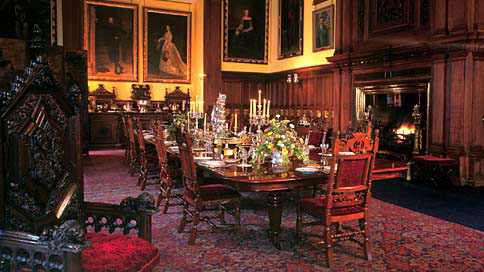 The Dining Room |
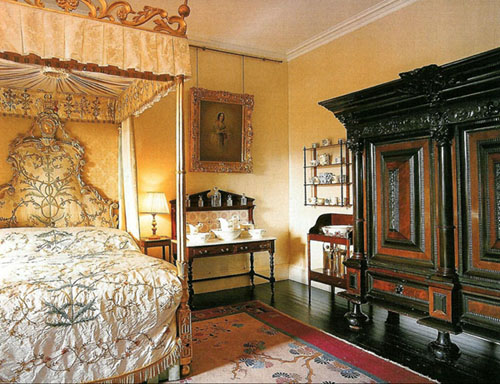 A Typical Bedroom |
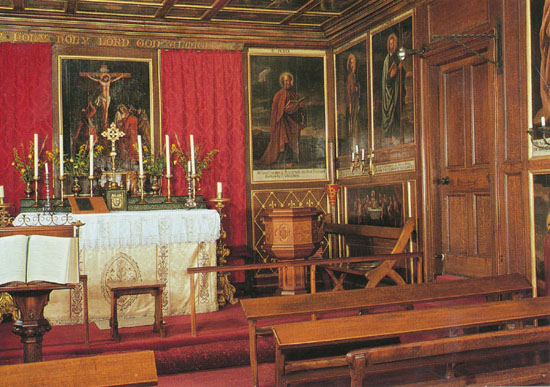 The Family Chapel |
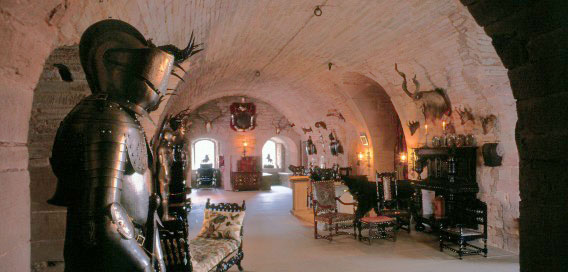 The Crypt |
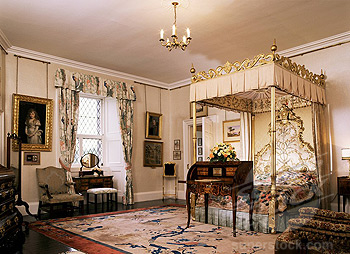 The Queen Mother's Bedroom |
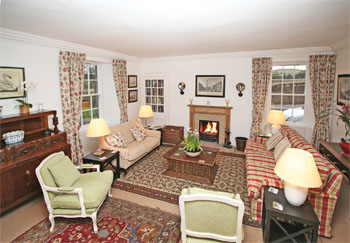 The Queen Mother's Sitting Room |
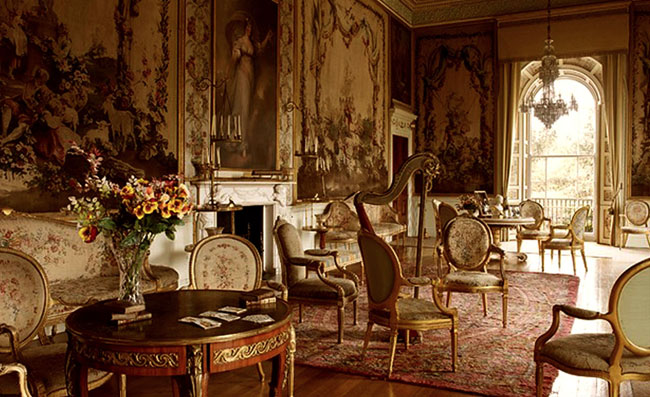 The Ballroom |
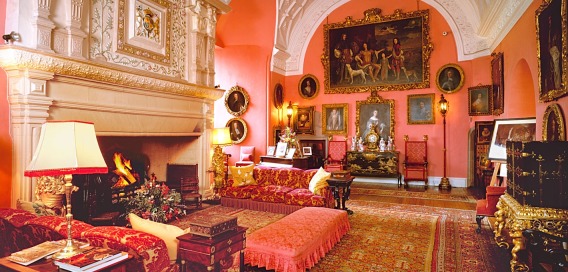 The Drawing Room (Family Room) |
The rest of the time, we walked around the outside of the castle, to see as much of it as we could. But we could only get close around on the west side, since the front and east side were either a garden or private for the Lyons, who still live here.
|
The clock tower houses the castle's archives which include a wide range of historical material relating to the castle and the Bowes and Lyon families. These include a papal bull and the memoirs of Mary Eleanor Bowes. The Glamis archives have a close connection with the archives at the University of Dundee, and researchers who wish to consult material held in the Glamis Castle Archive do so in the search room at the University.
The archives are on the upper level, the lower level gives access to the stairs that lead up to the crypt and to two other rooms- the ballroom and the dining room. The Clock Tower is just one of the castle's many turrets.
I thought the views of the castle from this direction were excellent, and I took a number of pictures from this angle. You can use the clickable thumbnails below to see three of them:
 |
The odd thing about the apron in front of the entry was the row of antique vehicles parked there. Since we'd already been on the tour, I did not have the opportunity to ask the guide whether the cars belonged to the Earl, but I have since found out that they do not- at least, not all of them.
|
We all found the cars interesting, and we all took pictures. There were six different vehicles altogether, and Fred took two pictures showing each of the vehicles. You can use the clickable thumbnails below to see each of these pictures:
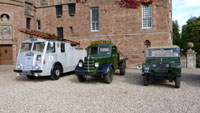
|
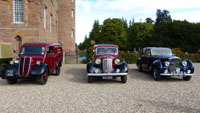
|
In case you are interested, I have put clickable thumbnails below for a selection of the other pictures we took of the vehicles and ourselves. Ron Ruckman, particularly, give the appearance of being to the manor born:
 |
When you look at Glamis from the outside now, it doesn't give the typical appearance that the word "castle" might conjure up. Sure, there are turrets and such, so it looks in places like Cinderella's Castle in the Magic Kingdom, but most of the the structure just looks like an old house, albeit a very, very large one, as you can see in this view from the front.
|
 |
That was about it for the castle itself, so now we were going to walk across to the Italian Garden.
The Italian Garden at Glamis Castle
|
We'll take a look at each of these, but our first stop was at the Glamis Sundial.
|
These sundials are often found on 17th century churches, on stately or historic homes or in their gardens, at market crossroads, and often on the walls of houses in 17th century villages. These are not the simple sundials you may be used to seeing; they were elaborate affairs, blending statuary and functionality. These complicated structures had multiple dials to reflect different aspects of timekeeping, and sometimes the statuary was an integral part of the dial. The Scottish mind for mathematics and science took the multiple dial in a way that is found nowhere else. These dials are a masterpiece of the dial makerís art and are a highly distinctive product of Scottish craftsmanship. They show a remarkable passion for dialing in all its most complex mathematical forms.
Sundials on churches and at market crossroads were truly functional and served a real purpose, whilst others on and around the stately homes were likely to have been the status symbol of the day and were intended to show how important, knowledgeable and wealthy the owners were. The sundial at Glamis Castle is one of the largest and most complex; it has 84 dials.
Seeing these sundials in a garden is interesting, but seeing one with a castle such as Glamis in the background is really impressive. Beginning at the sundial, there was a rope guiding walkers to the beginning of the short garden trail, so we followed it around to cross a small road and enter the woods. All along the way there were great views of Glamis Castle behind the trees.
Just across the road and just inside the woods there was an area off to the side of the trail that turned out to be a pet cemetery; presumably, the gravestones marked the final resting places of various pets that had lived at the castle. One marker seemed to be for multiple cats and another was for a pet guinea pig. And just down the trail was a huge Noble Fir (Abies Procera). A plaque on its immense trunk said that the tree, native to the Western United States, was established at Glamis in 1830.
A little ways down the trail we came to the garden gate, and its admonition to help keep the rabbits out of the garden.
|
|
I made a movie just inside the garden, and you can have a look at it by using the player at left.
|
Standing next to the memorial, we could see trails leading off into the woods and over to the Walled Garden (where we didn't go). From my position near the memorial, I could get a good picture of Fred, the corridor and the castle in the background, and you can see that picture here. Just after I took that photo, Fred got a very interesting shot of the roofs of Glamis Castle. I wonder if each fireplace in the castle has a single chimney ending in a single stack. If that's the case, then the Castle has a hell of a lot of fireplaces!
Back in the garden, we all wandered around admiring its construction, the plants and flowers and the fountain. Occasionally, we'd sit down on a garden bench or in one of the gazebos. There were some gardeners at work trimming the amazing shaped‑tree corridors. You can see what these corridors looked like under the canopy here.
|
 |
Prudence got a nice picture of Guy and myself, and the flowers, of course, were quite beautiful.
|
To view the slideshow, just click on the image at left and I will open the slideshow in a new window. In the slideshow, you can use the little arrows in the lower corners of each image to move from one to the next, and the index numbers in the upper left of each image will tell you where you are in the series. When you are finished looking at the pictures, just close the popup window.
The Italian Garden was very pretty; after we left, we spent some additional time walking around Glamis Castle and browsing in the gift shop before returning to the van for the continuation of our trip up to Aberdeen.
The Drive to Aberdeen
|
It was a nice day for a drive, and the scenery along the way was quite pretty. Apparently, this part of Scotland, at least, is mostly farmland, and they seem to grow a fair amount of wheat or other grains, and there was lots of livestock grazing on the gently rolling hills. Fred had a window seat for this portion of the drive, and he captured the pastoral nature of the passing countryside quite nicely in some photographs, and you can use the clickable thumbnails below to see some of the best of them:

|
Eventually, the A90 got close enough to the eastern coast of Scotland that we could begin to see the North Sea off to our right.
|
The Craighaar, like the Avon Gorge in Bristol, was a hotel, rather than a bed and breakfast or guest house. I'd kind of gotten used to smaller places, but the hotel was certainly nice enough.
|
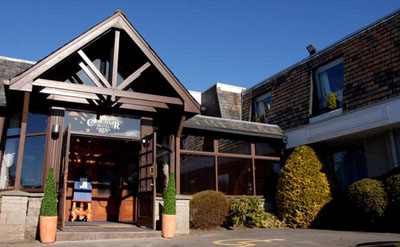 |
Fred and I helped everyone with their luggage, and we all found our rooms with not much problem. The hotel reminded me of hotels in at ski resorts- very Nordic.
|
There weren't any restaurants within walking distance of the hotel, it being out by the airport, so we decided to drive downtown to find one. Before we did that, we looked online to see what there was, and settled on a place in a new shopping mall created over the main railway station. It was called The Handmade Burger Company, and it was intriguing in that it served drinks and wine by the glass or bottle. Ron drove and I navigated and we ended up in a parking garage adjacent to the mall, walked over, had dinner, had coffee at a little bakery kiosk afterwards and then returned to the Craighaar.
You can use the links below to continue to another photo album page.
 |
September 18, 2013: Crathes Castle and Aberdeen, Scotland |
 |
September 16, 2013: A Day in Stirling, Scotland |
 |
Return to the Index for Our British Isles Trip |